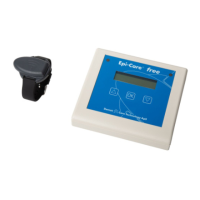
Do you have a question about the Danish Care Epi-Care free and is the answer not in the manual?
| Target User | People with epilepsy |
|---|---|
| Sensor Type | Accelerometer |
| Power Source | Rechargeable battery |
| Water Resistance | Splash resistant |
| Product Type | Wearable |
| Portability | Wearable |
Instructions on how to wear the sensor on the wrist for optimal movement detection and proper fit.
Steps for recharging the sensor's built-in battery using the provided micro USB charger.
Guidance on placing the control unit and inserting the SIM card for network access.
Configuring the primary phone number to receive alarm calls via SMS text messages.
Setting custom text messages to be sent with alarms or notifications for better context.
Setting an alternative number to receive alarms if the primary number is unavailable.
Verifying the programmed alarm number, text, and backup number by checking unit menus or sending commands.
Instructions on how to remove saved alarm numbers, texts, or backup numbers via SMS commands.
Explains the visual and audible signals indicating normal operation and sensor status.
Details the signals and actions taken when a seizure is detected, including red LEDs and beeping.
Describes signals for sensor out-of-range or power loss, indicating monitoring disruption.
Explains how the device indicates loss of cellular network connection, affecting alarm transmission.
Accessing and viewing the event log, including alarms, connection status, and movement activity.
Adjusting the audible signal volume and setting the device clock time and date.
Viewing stored GSM information like alarm numbers, text, and backup telephone numbers.
Deleting all stored reports from the control unit's log via the menu option.
Safely turning off the control unit using the menu option.
Returning to the monitoring mode from the menu system.
Suggestion to add the device number to the caretaker's phone contacts for immediate caller identification.
Instructions on how to reset the device manually by pressing the OK button when connected to an external call system.
Information about the sensor's resistance to water and activities to avoid, like showering or immersion.
Explanation of the operational range and consequences of exceeding it, including disruption of monitoring.
How the unit operates on backup battery during a power outage before shutting down.
Information on when to replace the sensor's battery (after ~2 years) and how to obtain a replacement.
How repeaters can be used to extend the device's communication range.
Solutions for issues related to the SIM card, including PIN locks and network errors.
Steps to disable the GSM communication feature and requirements for alternative call systems.